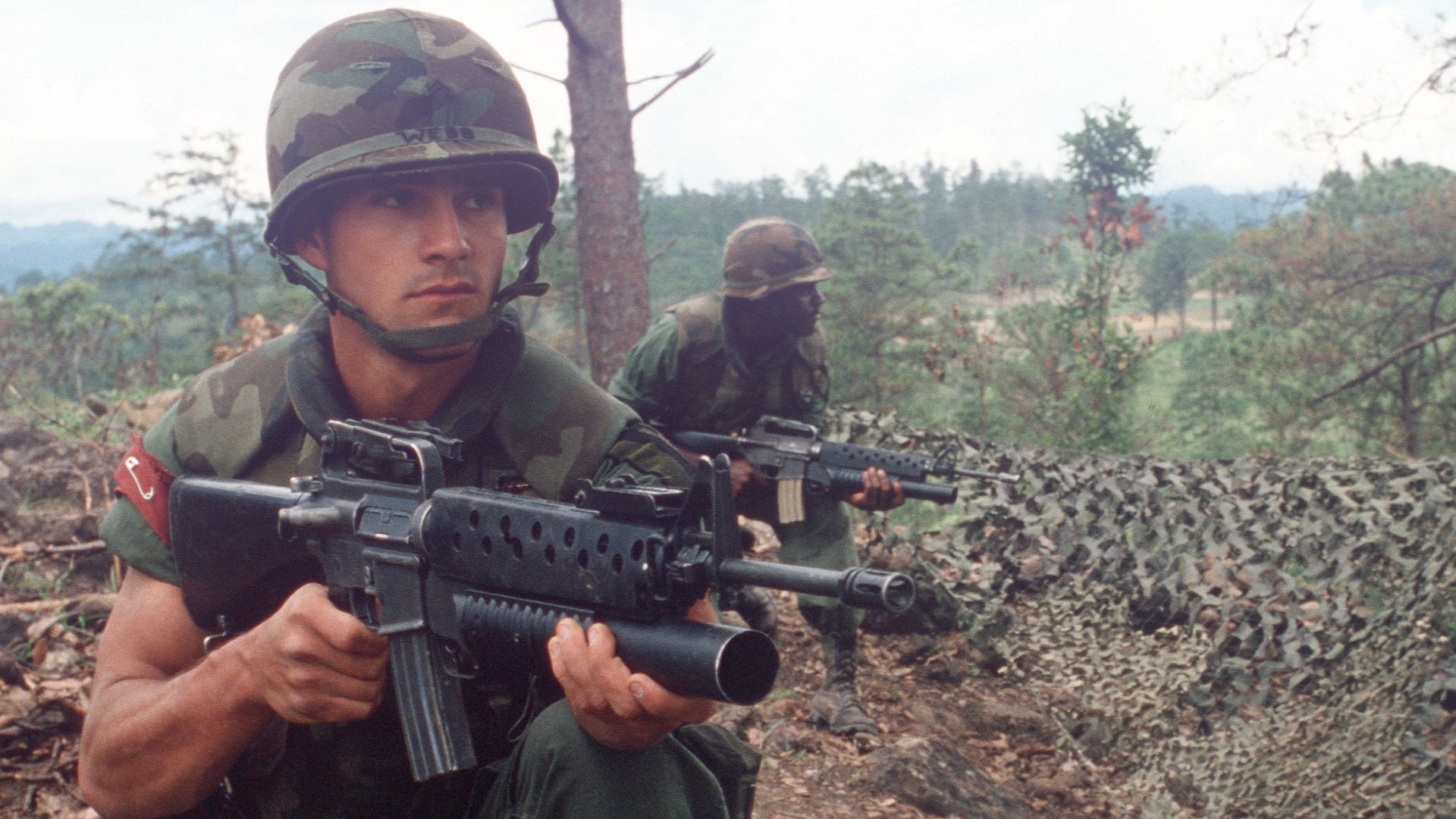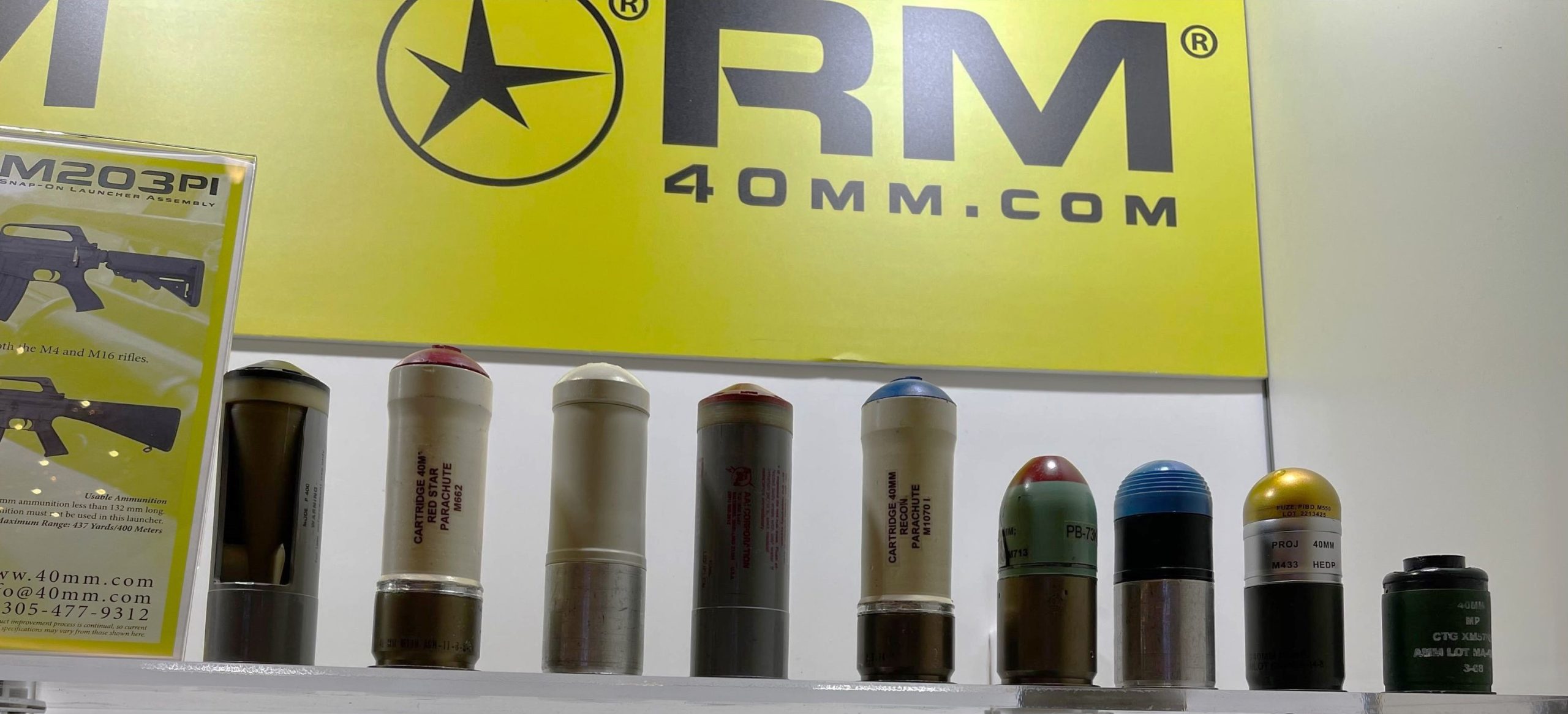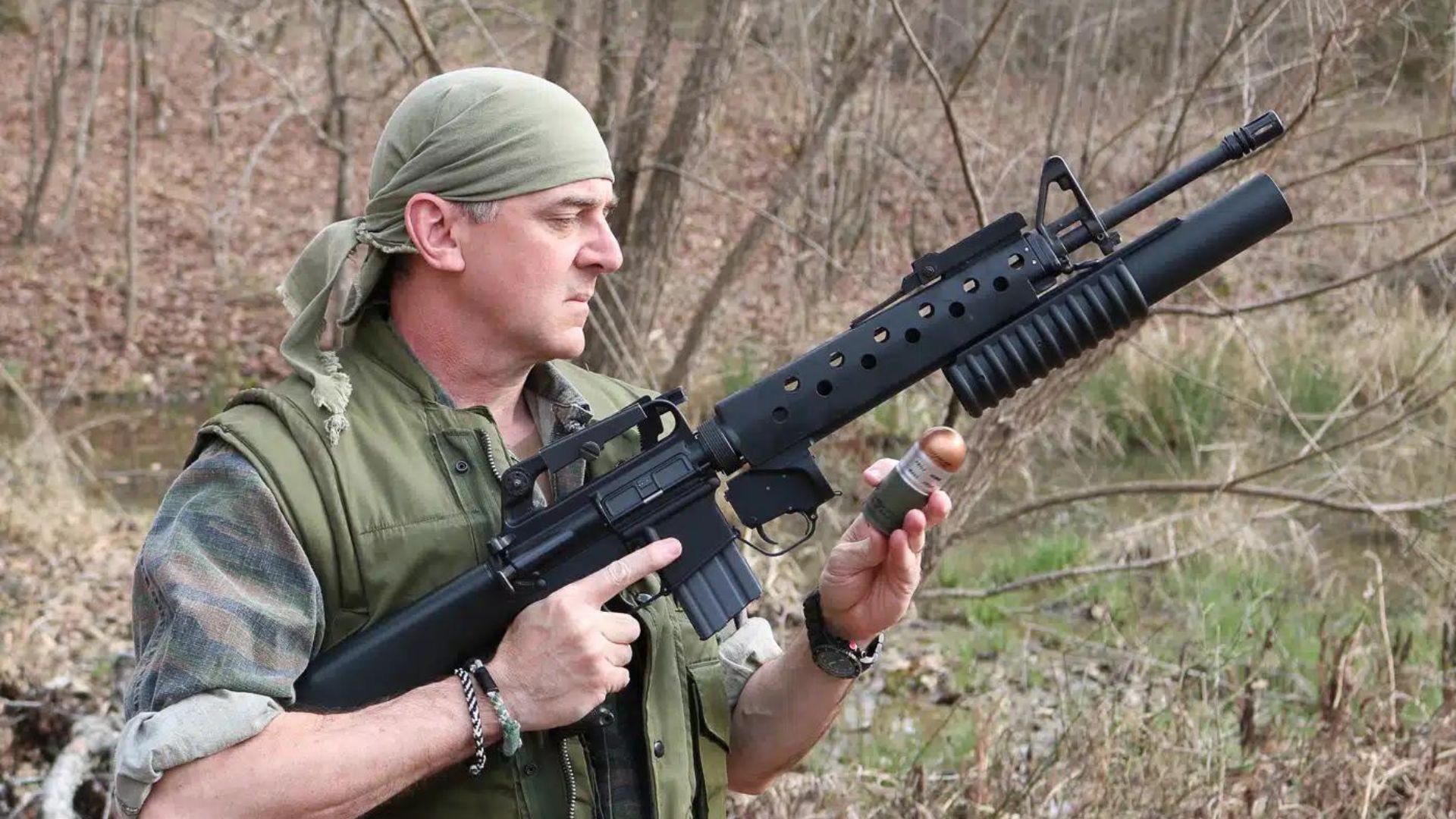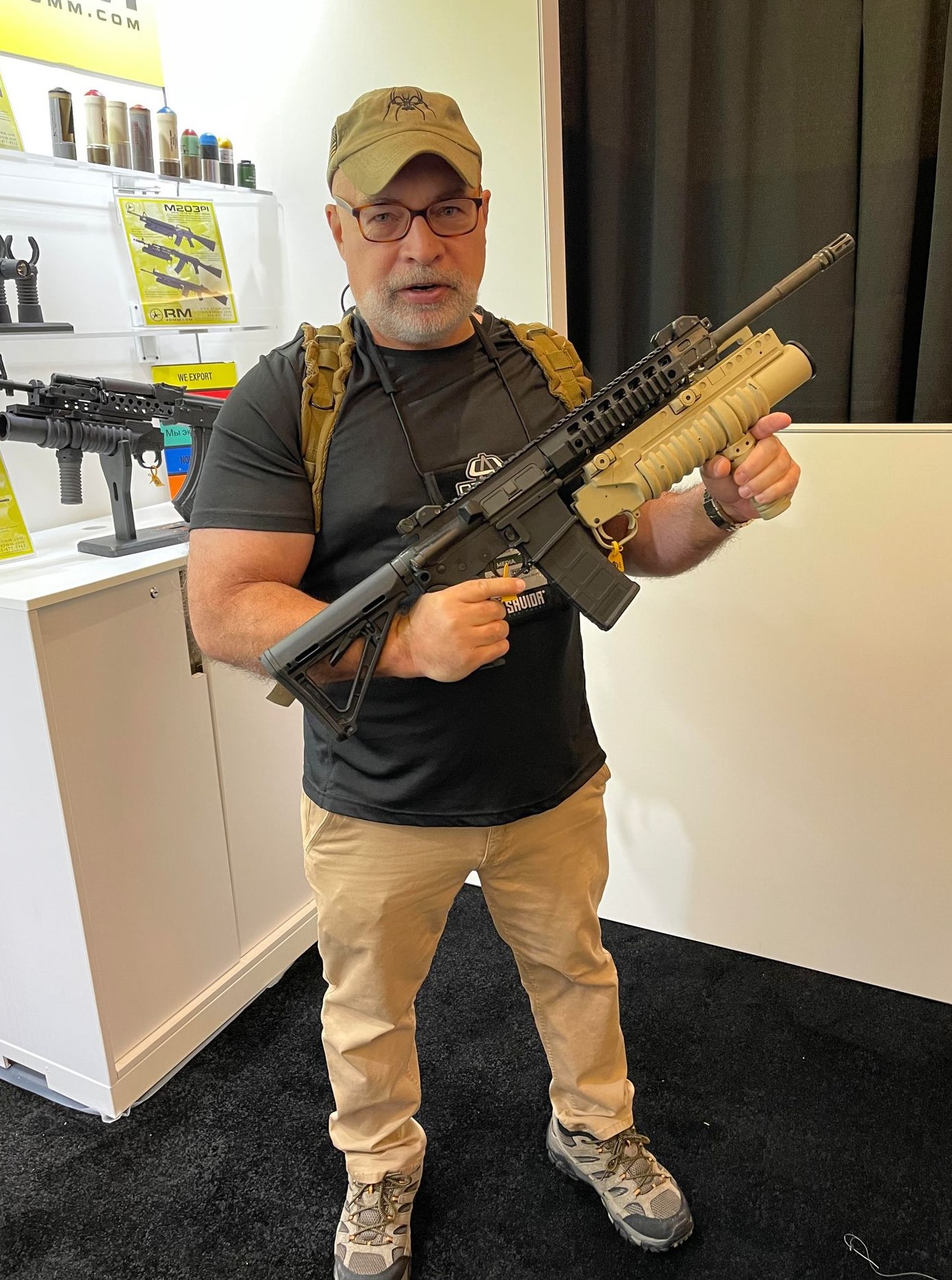The M203 grenade launcher has been a vital part of the U.S. military’s arsenal since its introduction in the late 1960s. Designed to attach under the barrel of a standard military rifle, this 40mm single-shot launcher provides soldiers with enhanced firepower in a compact, versatile package.
Originally developed for the M16 and its carbine variant, the M4, the M203 allows soldiers to switch quickly between direct rifle fire and launching grenades. Over the years, its reliability and adaptability have made it a staple in various combat scenarios, cementing its place in military history.
Background
The M203 grenade launcher is a single-shot, 40mm, under-barrel attachment designed to enhance the firepower of a standard rifle.

It is a proven system, compatible with various rifles. But it was originally crafted by the U.S. military for the M16 and its carbine variant, the M4. The M203 uses the same 40mm rounds as the older M79 grenade launcher, employing a high-low propulsion system to manage recoil.
Design and Functionality
The M203 attaches under the rifle barrel, with the launcher trigger just ahead of the rifle’s magazine. The rifle magazine serves as a handgrip when firing.
The rifle’s standard sights don’t align with the launcher, so an additional sighting system is added. For the Canadian C7 (a version of the M16), this sight can be mounted on either side of the launcher.
There are also stand-alone variants of the M203, along with models designed for various other rifles. These variants maintain the core functionality while adapting to different platforms. The launcher’s adaptability makes it a reliable tool in different combat scenarios, ensuring that soldiers can rely on it across various engagements.
Vital Statistics
The M203 Grenade Launcher is a single-shot, 40mm weapon designed to be mounted under the barrel of standard-issue rifles such as the M16 and M4.
With a barrel length of 12 inches, the M203 provides infantry units with a compact yet powerful tool for launching a variety of grenades.
This includes high-explosive, smoke, and illumination rounds. Weighing approximately 3 pounds when unloaded, the launcher adds minimal weight to the overall weapon system. This then allows soldiers to maintain mobility and effectiveness in the field.
The M203’s rifled steel barrel ensures accuracy over extended ranges, making it an essential component of modern infantry arsenals.
Constructed primarily from anodized aluminum, the M203 is both lightweight and durable, designed to withstand the rigors of combat. The launcher features a break-open action for easy loading and unloading, allowing soldiers to quickly respond to changing battlefield conditions.
The M203’s versatility is further enhanced by its compatibility with a wide range of 40mm ammunition types, enabling it to serve multiple roles on the battlefield, from engaging enemy personnel to providing smoke cover or signaling.
Its rugged design and reliable performance have made the M203 a trusted tool for military forces around the world, maintaining its status as a key asset in various combat scenarios.
Historical Context
The M203 emerged from the U.S. Army’s Special Purpose Individual Weapon (SPIW) project and has been in service since 1969. It was introduced to replace the M79 grenade launcher and the Colt XM148.
Unlike the M79, which was a standalone weapon, the M203 was designed to be an under-barrel device attached to an existing rifle. This design allowed soldiers to carry both a rifle and a grenade launcher, providing flexibility in combat.
The ability to switch between direct fire and launching grenades made the M203 a valuable asset in diverse combat situations.
Although the M320 grenade launcher is slated to replace the M203 in the U.S. Army, other branches like the Marine Corps, Air Force, Coast Guard, and Navy have continued using the M203. The M320, introduced to the Marines in June 2017, offers some advancements. But the M203’s reliability and effectiveness have kept it in service.
Applications in Combat
The M203 is primarily used for close fire support, targeting areas and points where direct fire can’t reach. Its 40mm rounds are effective at penetrating windows, blowing up doors, disabling vehicles, and taking out bunkers. During the Vietnam War, U.S. Navy and Coast Guard personnel used similar 40mm rounds to target Viet Cong swimmers attempting to sabotage U.S. boats.
It saw extensive use in both Iraq and Afghanistan, helping to keep the bad guys at a distance.
The launcher’s ability to engage enemies in dead spaces makes it an essential tool in urban and jungle warfare. Trained M203 gunners can suppress enemy movements, providing crucial support to their units. The M203 can also be used in crowd control when equipped with CS (tear gas) rounds.
Types of Ammunition

The M203 can fire various rounds tailored to different combat needs. According to the U.S. Army Field Manual FM 3-22.31, there are eight main types of rounds for the M203:
- M433 High-Explosive Dual Purpose (HEDP) Round: This round can penetrate armor and has a casualty radius of 130 meters, making it effective against both personnel and lightly armored vehicles.
- M406 High-Explosive (HE) Round: Similar to the HEDP, this round is designed for anti-personnel use, with a kill radius of 5 meters.
- M583A1 Star Parachute Round: Used for illumination and signaling, this round deploys a parachute to slow its descent, providing light for about 40 seconds.
- M585 White Star Cluster Round: This round is also used for illumination and signaling, with individual stars burning for about 7 seconds.
- M713 Ground Marker Round: This round is used for marking positions on the ground, with a smoke indicator to signal location to aerial units.
- M781 Practice Round: Designed for training, this round produces a visible signature upon impact, allowing for safe practice with the launcher.
- M651 CS Round: This round releases tear gas upon impact, making it effective for riot control and urban operations.
- M576 Buckshot Round: Effective in close quarters, this round contains 20 metal pellets, making it suitable for room clearing and dense vegetation.
Variants and Evolution
The M203 has evolved over the years, with several variants being developed to meet different operational needs. The standard M203 is designed for permanent attachment to the M16A1, A2, and A3 rifles and features a 12-inch rifled barrel. The M203A1 variant, with a 9-inch barrel, is specifically designed for the M4 and M4A1 carbines and includes a special bracket mount for attachment.

The M203A2 is intended for use with the M4 series and M16A4. It features range-finding optics for precise targeting. The M203PI system allows attachment to various other rifles, such as the Steyr AUG and Heckler & Koch G3.
Other notable variants include the M203 DAX, which has a double-action trigger, and the M203 37mm version, a non-lethal variant available on the U.S. market since 2017. These variants reflect the M203’s adaptability and continued relevance in modern combat scenarios.
Continued Production and Use
The M203 and its variants are still being produced for the U.S. Department of Defense and law enforcement agencies, both domestically and internationally. AIRTRONIC USA, Inc. manufactures the M203 and M203A1, while RM-Equipment Inc. produces the M203PI for both military and commercial sales.

The Turkish MKEK T-40 grenade launcher is based on the M203, which demonstrates its global influence and continued use. The M203’s design has stood the test of time, and its versatility ensures it remains a critical tool in the arsenal of the U.S. military and its allies.
Legal Considerations
The M203 grenade launcher is tightly regulated under U.S. law. This is due to its classification as a destructive device under the National Firearms Act (NFA). It’s kind of hard to justify one of these as a home defense weapon because that is not what they were designed for. Still, it’s fun as hell to take out to the country, chunk out some rounds, and blow up random patches of dirt. A little pricey but fun.
Individuals and entities wishing to own or transfer an M203 must undergo an extensive background check. Applicants must also register the device with the Bureau of Alcohol, Tobacco, Firearms and Explosives (ATF) and pay a federal tax. That said, if you really want to own one, it is possible. And who wouldn’t want one of these bad boys?
Additionally, the ammunition for the M203, particularly high-explosive rounds, is subject to further legal restrictions. All these make civilian ownership and use of the launcher highly controlled and limited.
Final Verdict
The M203 grenade launcher has been a reliable and effective tool for U.S. military forces for over five decades. Its adaptability, range of ammunition types, and ability to provide close-fire support make it an invaluable asset in various combat scenarios.
While newer systems like the M320 are being introduced, the M203’s legacy and continued use across different branches of the military speak to its enduring value. As long as there’s a need for versatile, powerful support weapons in the field, the M203 will remain a trusted option for soldiers on the ground.
__
Disclaimer: SOFREP utilizes AI for image generation and article research. Occasionally, it’s like handing a chimpanzee the keys to your liquor cabinet. It’s not always perfect and if a mistake is made, we own up to it full stop. In a world where information comes at us in tidal waves, it is an important tool that helps us sift through the brass for live rounds.










COMMENTS
You must become a subscriber or login to view or post comments on this article.